Identify Your Fish
Some of the species found in Loveland Lake incude:
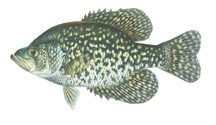 Black Crappie
Black Crappie
Crappie are a pan-shaped fish with black splotches on a silver background, whose dorsal spines and rays get longer as they approach the tail.
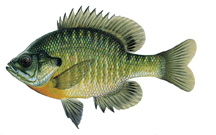 Bluegill
Bluegill
This sunfish has a short and deep body. As with all sunfish, the dorsal (top) fin is not split. The bluegill has a small mouth on a short head and a dark gill flap with no trim. There are parallel vertical bars on the side with long, pointed pectoral (side) fins. A male bluegill in breeding colors has brilliant blue fins and a red-orange stomach. The female bluegill is dark on the back with vertical stripes on the body.
 Channel Catfish
Channel Catfish
Channel cats are native to eastern Colorado and have been stocked in warmer rivers and reservoirs throughout the state. These fish are easily identified by their barbels (whiskers), forked tail and sporadic black spotting.
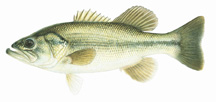 Large Mouth Bass
Large Mouth Bass
This fish has a very big mouth and its jaw extends past the eye. You can also distinguish them as the bass with the horizontal stripe on their body.
 Rainbow Trout
Rainbow Trout
Rainbows can be found in most mountain lakes and streams, as well as many plains reservoirs. Physical characteristics that can help distinguish rainbow trout include dark spots on a light body, continuous spotting throughout the body, and often a “rainbow” horizontal reddish stripe.
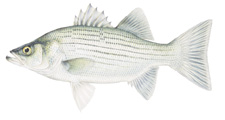 Wiper
Wiper
This fish is a hybrid between white bass and striped bass. Wiper have become a very popular sportfish because of their hard fighting.
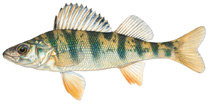 Yellow Perch
Yellow Perch
The yellow perch may be Colorado’s most abundant game fish and one of the most table worthy. Yellow perch have two separate dorsal fins with large vertical dark stripes on their yellowish sides.
All fish illustrations are copyright Joseph R. Tomelleri and are used with his permission.